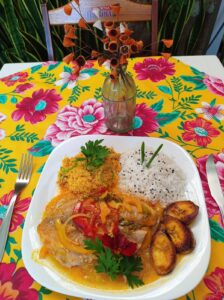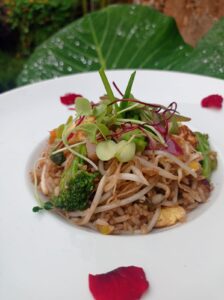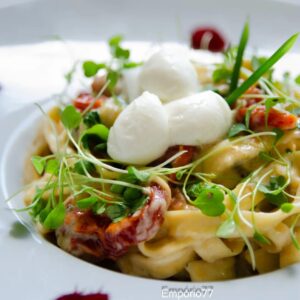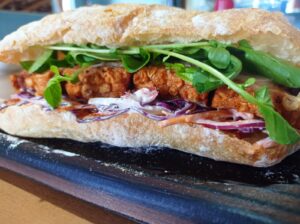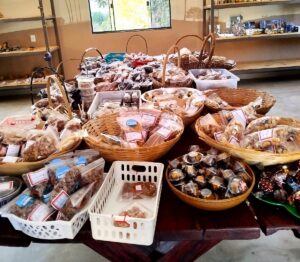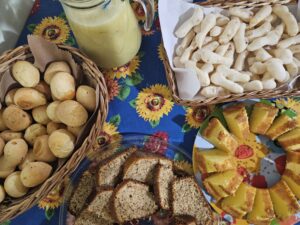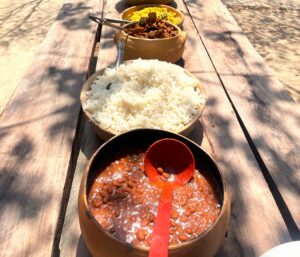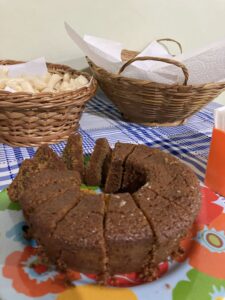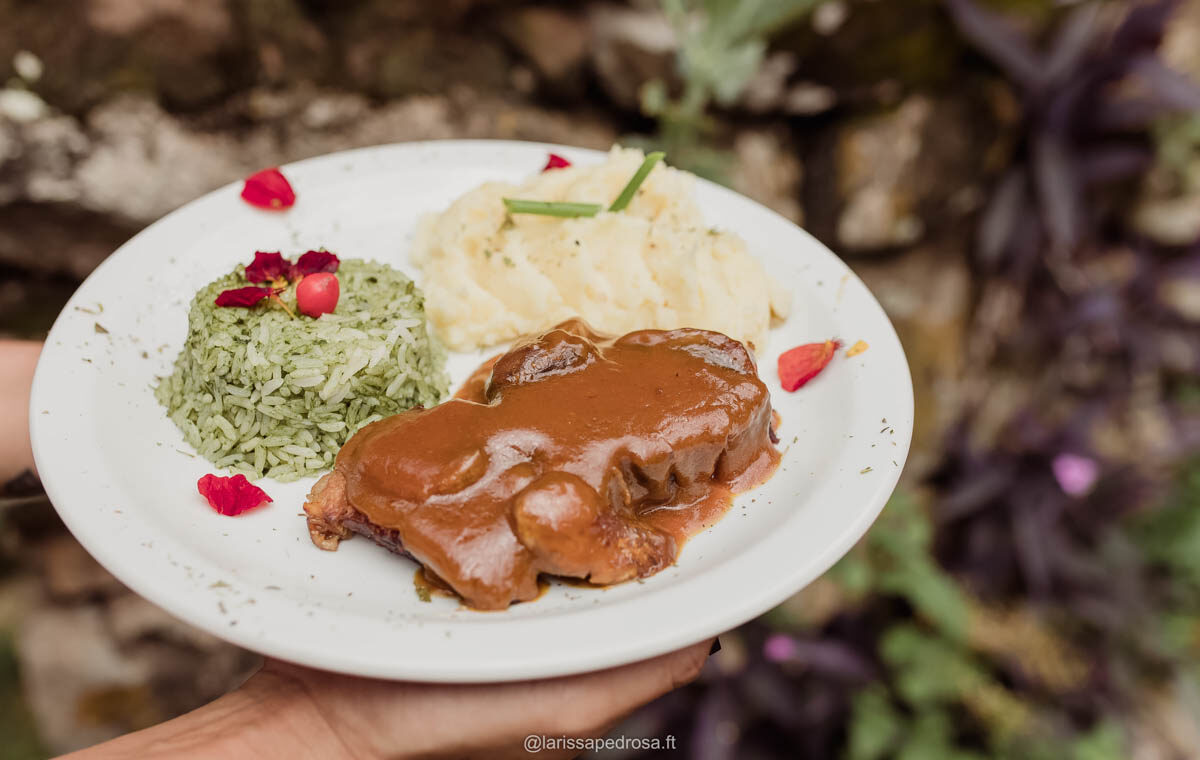
Food is much more than the ingredients in a pot. It carries memories, stories, and traditions that span generations. In the concept of affective food, each dish can be a bridge between the present and the past, revealing the cultural and family roots of those who prepare it.
Many of the ingredients and techniques we use today have links back to the practices of our ancestors. This connects us with our origins, while at the same time, sharing these legacies with new generations.
Here at Raízes SD, we believe that ancestry is preserved through food. In some of our projects, we work with gastronomic businesses. And today, in our chat with beneficiaries, we brought representatives from Bistrô Empório 77 and Fábrica de Biscoito do Quilombo São Domingos to talk about affective food.
Check out the interview below:
 Carolina Machado, or Carola – as she likes to be called – runs Bistrô Empório 77, a charming gastronomic space in the historic neighborhood of Matozinhos, in Itabirito, Minas Gerais. The business was one of the beneficiaries of the Projeto de Desenvolvimento Territorial e Transformação Social de Itabirito – MG, a Vale initiative, run by Raízes.
Carolina Machado, or Carola – as she likes to be called – runs Bistrô Empório 77, a charming gastronomic space in the historic neighborhood of Matozinhos, in Itabirito, Minas Gerais. The business was one of the beneficiaries of the Projeto de Desenvolvimento Territorial e Transformação Social de Itabirito – MG, a Vale initiative, run by Raízes.
At the start of the project, the bistro was closed, operating only as a lunch delivery service due to the Covid-19 pandemic. During the incubation process, Carola restructured management, redefined communication, and, using creativity, offered a menu full of emotional memories and regional identity.
Raízes: How do the local environment and history influence the creation of your dishes and the gastronomic experience you seek to provide your customers?
Carola Machado: I believe that history influences every chef’s creative process, whether through the food culture of a region, families, or a particular economic activity. Minas Gerais has this characteristic: our cuisine has been influenced by Europeans, Africans, and native peoples. When we delve into the local history and customs, a huge box of possibilities and ingredients are also discovered, and people love to know that they are immersed in the environment that generated the inspiration.
A: Which food evokes the most emotional memories for you?
CM: A people’s food culture tells their story through their palate. Usually, with simple, everyday preparations, that angu with a stew, a tutu with a tasty sauce and egg on top, tinned meat with the unmistakable flavor of lard, but what really wins my heart is codfish with chayote and angu de fubá de moinho d’água. But the salted pork with chayote and angu is also a taste of my childhood right here in this house, and it’s too difficult to find just one dish that is dear to my heart, given the vastness of our region’s food.
R: How has Itabirito’s territorial development and social transformation project contributed to your business?
CM: The project was essential for both the transformation and the resumption of activities. Without it, with the impact of the pandemic on the business, it wouldn’t have been possible to resume activities, it would have been lost until we started again through the project.
R: How do you choose the ingredients and recipes that best represent Minas Gerais cuisine and your own personal journey?
CM: First of all, I always think about buying local products. Nowadays, in this globalized world, we have access to a huge number of new and interesting ingredients, and I like this fusion. On our table, there will always be pork rinds, tutu, tropeiro, and chicken with okra. Now, for example, I’m immersed in the world of pasta and one of the fillings is the caipira pork with jabuticaba peel jam that we prepare here. So it’s possible to maintain tradition, re-invent and create, and bring unusual flavors to the table using local ingredients and assisting the local economy.
_
The Fábrica de Biscoitos do Quilombo São Domingos (São Domingos Quilombo Biscuit Factory) aims to revive the culinary tradition of the São Domingos community, in Paracatu – MG, through the handmade production of pies, breads, cakes, rusks, and cookies. The initiative has a group of eight women who produce recipes that are passed down from generation to generation and tell the story of the community.
The factory also promotes Café no Quilombo, which highlights the community’s culinary tradition. The Tourism Development Plan for the São Domingos Quilombo in Paracatu – MG is an initiative of Sebrae MG with execution by Raízes Sustainable Development, which began in June 2023. The main objective of the actions is to develop a sustainable source of income that values the local quilombola culture.
 Irene dos Reis, one of the leaders of the São Domingos Quilombo, told us a little about the connection between food and ancestry in the community.
Irene dos Reis, one of the leaders of the São Domingos Quilombo, told us a little about the connection between food and ancestry in the community.
Raízes: What ingredients and techniques do you maintain as part of Paracatu’s culinary ancestry, and how do these elements relate to the quilombo’s cultural identity?
Irene dos Reis: The truth is that Paracatu’s cuisine carries the knowledge and skills of the quilombola culture. We have preserved ingredients such as corn, manioc, cheese, pequi, rapadura, molasses, peanuts, and traditional techniques such as the preservation and way of doing things of our ancestors. These elements reinforce the community’s identity and resistance, keeping our people’s ancestral heritage alive.
A: Food is a powerful link to our memories and roots. Which food evokes the most emotional memories for you?
IR: Each of these foods carries a unique flavor and memories of special moments that we lived in our community, in our family. The memory of our grandmothers’ love comes through, whether it’s the warm cheese bread, the simple and welcoming cornmeal cake, the remarkable taste of rice with pequi, the free-range chicken with green corn stew, the peeled manioc, the molasses with flour or cooked manioc, that homemade touch that brings the flavor and feeling of home and family.
R: How do you see the role of local gastronomy in strengthening cultural identity and social transformation in your community?
IR: Local gastronomy strengthens cultural identity by preserving traditions and uniting the community while promoting social transformation through economic empowerment, appreciation of regional products, and education about sustainability.
R: How does preserving these recipes and ways of preparing them contribute to the visibility of Paracatu’s quilombola culture?
IR: Living culture! It is an act of resistance and cultural affirmation that contributes to the visibility and appreciation of the rich heritage of our ancestors left to this community and its descendants.
As well as feeding the body, emotional food feeds the soul! Cooking becomes an act of resistance, where the revival of food traditions not only values local culture but also strengthens the self-esteem of those who identify with these practices.
Preserving these roots through food is a way of honoring ancestry and, at the same time, reinventing traditions in an ever-changing world.
